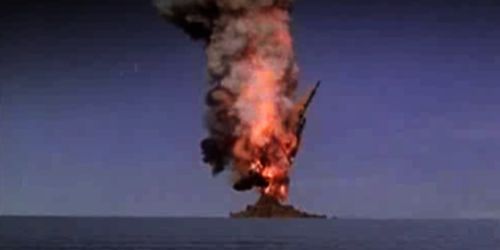This was the year of the first true ‘talkie’, The Lights of New York, along with the first cartoon with a properly synchronized soundtrack, Disney’s Steamboat Willie, and the first ‘silent’ with a synchronised soundtrack, White Shadows in the South Seas.
Director: Bryan Foy (USA).
Cast: Cullen Landis, Helene Costello, Wheeler Oakman, Gladys Brockwell.
Plot: A young man from Upstate New York is conned into fronting for a speak-easy on Broadway. (Source: IMDb.)
Review: A small confession: I didn’t actually watch The Lights of New York, apart from YouTube clips and also gleaned information from various web reviews. The blog is, very importantly, about enjoyment, and I didn’t want to spend an hour watching something with a scratchy soundtrack and dull plot. Historically, it was dynamite. The audiences loved it, and within 18 months, Hollywood was producing ‘talkies’ exclusively. So, apologies for skipping this one. Of historical interest, but not of great quality otherwise.
Score: from the bits I’ve seen, 1/10, and strictly because of the historical interest.

Mickey and Minnie (short for Minerva) Mouse.
Director: Walt Disney. (Ub Iwerks is usually credited, but Disney was the driving force.)
Cast: Walt Disney (vocals).
Plot: Mickey mouse plays the tune Turkey in the Straw over and over again, using various animals as instruments.
Review: Not the first Mickey Mouse appearance, neither the first cartoon with synchronized sound, but the first to do it moderately well with previous attempts achieving little more than childish flick-book quality.
It is, of course, difficult to really watch this in the spirit of it’s time, but all the same it is a dull affair. Is it made to entertain? Is it intended to amuse adults or children? Is it at any point funny? There is no danger, edge or risk-taking in the humour.
Score: 1/10.
The inspiration for the title was from the Buster Keaton (silent) movie of the same year, Steamboat Bill, Jr. The latter is most famous for the scene where Keaton escapes unscathed as buildings collapse around him.

Of mixed of American, French and Cherokee ancestry, Monte Blue endured tough times in his youth, living with destitute soldiers at one time and working as a coal miner and ranch hand at others. It was odd-jobbing that landed him in Hollywood, where he quickly built up a reputation as a romantic lead.
WHITE SHADOWS IN THE SOUTH SEAS
Director: W. S. Van Dyke (USA).
Cast: Monte Blue, Robert Anderson, Raquel Torres.
Plot: A down-an-out medic finds himself treated as a god by the inhabitants of an unexplored Pacific island, at a time when the introduction of European ideas are about to destroy the islanders’ idyllic lifestyle.
Review: Amongst the many black and white offerings from this period, particularly ones which portray aboriginal communities as low-brow, missionary-boiling, bongo-banging affairs, this was very refreshing. The majority of the cast were native Tahitians, with just the lead actors being from the US. The acting is pleasingly naturalistic, with only the occasional over-expressive look or gesture to remind us that this is a silent movie. The islanders are portrayed walking about, working, sleeping, working, drinking, hanging out … i.e., behaving just like normal people.

Raquel Torres, a romantic lead and femme fatale for a brief period, abruptly retired on getting married in 1936, aged 27, and never even made a TV appearance after that. She died in 1987.
The male star of the movie is Monte Blue, a prolific actor who had credited and uncredited parts in score of movies into the 1960s. He plays a wastrel doctor, railing against the exploitation of the natives in the quest for pearls for western markets.
Blue is beaten up and cast adrift by one of the traders, only to land on an untouched inhabited island – a sort of Shangri La of the South Seas – where he falls for the chief’s daughter, Raquel Torres. When he discovers that the waters are rich in pearls there, even he becomes temporarily obsessed with finding them, until his love for the girl brings him back to his senses. Alas, too late to prevent traders from spoiling the island paradise.
‘Silent’ with qualifications. The soundtrack was pre-recorded, with effects and even vocals added. Evidently the sound recording technology was not available to make the leap into ‘talkie’ territory. The film is unique in other ways, with underwater scenes, long tracking shots and being made on location in Tahiti (not the Marquesas Islands as claimed in the film’s intro), for which it deservedly won an Oscar.
Score: 5/10.
So, the best movie of 1928 is …
WHITE SHADOWS IN THE SOUTH SEAS (5/10)
 … because of the naturalism of the acting, pleasing lack of racial stereotypes, subtlety of storyline and imaginative camera work.
… because of the naturalism of the acting, pleasing lack of racial stereotypes, subtlety of storyline and imaginative camera work.
The next ‘The Best Movie of …’ will be the year 2005.





 There are elements of fact in the film. Eida the Elephant was indeed born in Asia (Thailand, not Ceylon as in the movie) and survived heavy bombing in Rotterdam Zoo. There was also a ‘Lucy’ in Munich Zoo during the war, cared for by British POW Tom Wright, who later wrote a fictionalized story about his experiences, which became the premise for this film.
There are elements of fact in the film. Eida the Elephant was indeed born in Asia (Thailand, not Ceylon as in the movie) and survived heavy bombing in Rotterdam Zoo. There was also a ‘Lucy’ in Munich Zoo during the war, cared for by British POW Tom Wright, who later wrote a fictionalized story about his experiences, which became the premise for this film.






